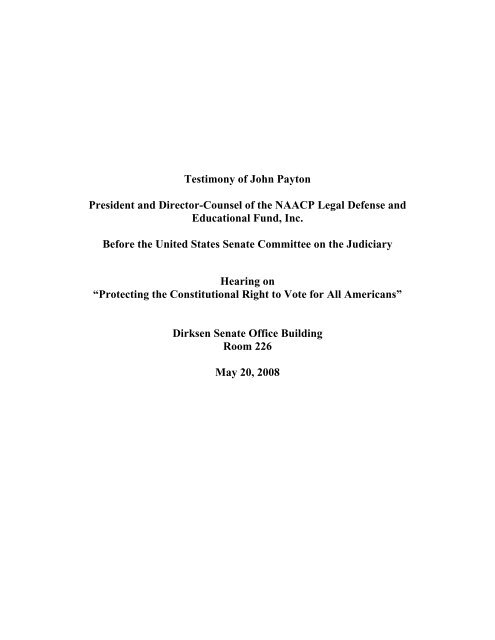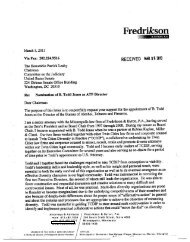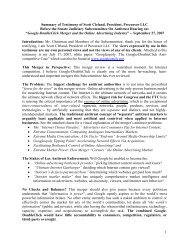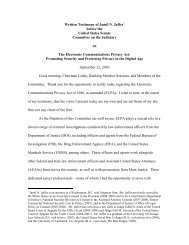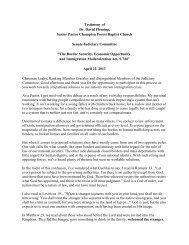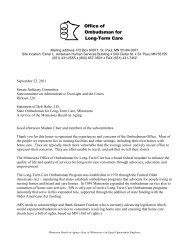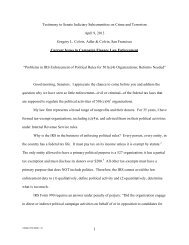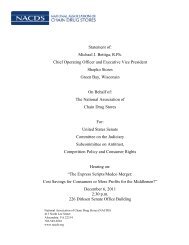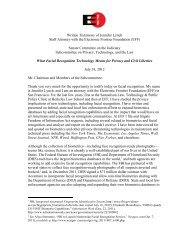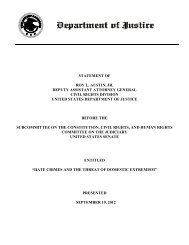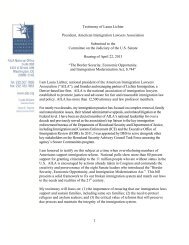Testimony of John Payton President and Director-Counsel of the ...
Testimony of John Payton President and Director-Counsel of the ...
Testimony of John Payton President and Director-Counsel of the ...
Create successful ePaper yourself
Turn your PDF publications into a flip-book with our unique Google optimized e-Paper software.
<strong>Testimony</strong> <strong>of</strong> <strong>John</strong> <strong>Payton</strong><br />
<strong>President</strong> <strong>and</strong> <strong>Director</strong>-<strong>Counsel</strong> <strong>of</strong> <strong>the</strong> NAACP Legal Defense <strong>and</strong><br />
Educational Fund, Inc.<br />
Before <strong>the</strong> United States Senate Committee on <strong>the</strong> Judiciary<br />
Hearing on<br />
“Protecting <strong>the</strong> Constitutional Right to Vote for All Americans”<br />
Dirksen Senate Office Building<br />
Room 226<br />
May 20, 2008
My name is <strong>John</strong> <strong>Payton</strong>, <strong>President</strong> <strong>and</strong> <strong>Director</strong>-<strong>Counsel</strong> <strong>of</strong> <strong>the</strong> NAACP Legal<br />
Defense & Educational Fund, Inc. (LDF). As <strong>the</strong> nation’s preeminent civil rights law firm,<br />
LDF has served as legal counsel for African Americans in numerous federal voting rights<br />
cases since <strong>the</strong> 1940’s, including Smith v. Allwright, 321 U.S. 649 (1944), in which <strong>the</strong><br />
Supreme Court invalidated <strong>the</strong> notorious white primary. More recently, LDF testified in<br />
support <strong>of</strong> <strong>the</strong> 2006 Congressional reauthorization <strong>of</strong> key provisions <strong>of</strong> <strong>the</strong> Voting Rights<br />
Act <strong>of</strong> 1965, <strong>and</strong> is now defending <strong>the</strong> Section 5 preclearance provision from <strong>the</strong> latest<br />
constitutional attack.<br />
The right to vote without unnecessary <strong>and</strong> unjustifiable restrictions is both a core<br />
feature <strong>of</strong> our democratic structure <strong>and</strong> a principle that has long shaped LDF’s litigation<br />
<strong>and</strong> advocacy efforts in <strong>the</strong> fight against barriers to political participation. LDF has been<br />
engaged in a decades-long fight that has now touched two centuries but <strong>the</strong> nation’s<br />
struggle to ensure <strong>the</strong> centrality <strong>of</strong> <strong>the</strong> vote spans back even far<strong>the</strong>r. In light <strong>of</strong> this long<br />
experience, we must view <strong>the</strong> Supreme Court’s decision in Crawford v. Marion County<br />
Election Board, 1 <strong>and</strong> <strong>the</strong> restrictive state legislation that gave rise to it, in its proper<br />
perspective. Restrictive photo identification measures are unwarranted erosions <strong>of</strong> our<br />
democracy that, just as <strong>the</strong>ir predecessors, will not withst<strong>and</strong> <strong>the</strong> test <strong>of</strong> time. Like <strong>the</strong><br />
infamous poll taxes <strong>and</strong> gr<strong>and</strong>fa<strong>the</strong>r clauses before <strong>the</strong>m, <strong>the</strong>y are predicated on falsehoods<br />
<strong>and</strong> can be permitted to exist only if we are willing to embrace a cramped notion <strong>of</strong><br />
democracy intended to introduce a structural caste into our notion <strong>of</strong> “We <strong>the</strong> People.”<br />
If we wish to be regarded as <strong>the</strong> world’s leading democracy, <strong>the</strong> role <strong>of</strong> government<br />
must be to encourage greater political participation. In America in 2008, <strong>the</strong> vote must be<br />
treated as a right equally shared by all <strong>and</strong> not as a special privilege jealously guarded by a<br />
few. The Supreme Court’s recent decision to uphold <strong>the</strong> State <strong>of</strong> Indiana’s m<strong>and</strong>atory<br />
voter identification law in Crawford v. Marion County Election Board calls for <strong>the</strong> nation<br />
to reexamine <strong>the</strong> value that we place on <strong>the</strong> right to vote <strong>and</strong> to reflect upon <strong>the</strong> challenges<br />
that we still face in <strong>the</strong> struggle for equal political opportunity for all Americans.<br />
I am pleased to <strong>of</strong>fer testimony on <strong>the</strong> important issues facing <strong>the</strong> Senate Judiciary<br />
Committee as it considers ways to ensure that all Americans, regardless <strong>of</strong> race, age, or<br />
economic status, maintain <strong>the</strong> right to participate equally <strong>and</strong> fully in our political process.<br />
A Snapshot <strong>of</strong> Political Participation in <strong>the</strong> United States<br />
Among mature democracies, <strong>the</strong> United States has one <strong>of</strong> <strong>the</strong> lowest participation<br />
rates in <strong>the</strong> most important function <strong>of</strong> people in a democracy—<strong>the</strong> election <strong>of</strong> government<br />
<strong>of</strong>ficials. 2 The United States, <strong>and</strong> every individual state, should aspire to have <strong>the</strong> highest<br />
1 128 S. Ct. 1610 (2008), decided with <strong>the</strong> companion case Indiana Democratic Party, et al. v. Todd Rokita,<br />
et al.<br />
2 See, e.g., G. Bingham Powell, Jr., American Voter Turnout in Comparative Perspective, 80 AM. POL. SCI.<br />
REV. 17 (1986) (providing comparative discussion <strong>of</strong> <strong>the</strong> low level <strong>of</strong> voter turnout in <strong>the</strong> United States); see<br />
1
participation rates <strong>of</strong> any democracy by identifying effective measures that would help<br />
increase current levels <strong>of</strong> participation. Instead, we have seen a series <strong>of</strong> efforts that have<br />
<strong>the</strong> conceded effect <strong>of</strong> placing burdens on citizens’ attempts to vote. No one can<br />
reasonably claim that increasing <strong>the</strong> burdens on <strong>the</strong> exercise <strong>of</strong> <strong>the</strong> right to vote does not<br />
have <strong>the</strong> effect <strong>of</strong> depressing participation rates among voters in <strong>the</strong> most central aspect <strong>of</strong><br />
our democratic process.<br />
In <strong>the</strong> last year, <strong>the</strong>re has been a dramatic surge in registration rates among African-<br />
American voters in a number <strong>of</strong> states including Alabama, Louisiana, Tennessee <strong>and</strong> North<br />
Carolina, among o<strong>the</strong>rs. 3 This presidential election cycle, more than any o<strong>the</strong>r in recent<br />
time, has energized many citizens who have long been disinterested in or disengaged from<br />
electoral politics. In a number <strong>of</strong> states, African-American <strong>and</strong> young voters, in particular,<br />
are turning out to <strong>the</strong> polls in significant numbers, exhibiting a tremendous desire to<br />
participate in contests now on <strong>the</strong> ballot. As some commentators have aptly observed,<br />
“Democracy has been <strong>the</strong> real winner <strong>of</strong> <strong>the</strong> process.” 4<br />
The success story that has emerged during this election cycle, however, will prove<br />
to be a hollow victory if those newly registered voters are ultimately unable to cast <strong>the</strong>ir<br />
ballots on Election Day because <strong>of</strong> <strong>the</strong> onerous burdens imposed by m<strong>and</strong>atory voter<br />
identification requirements or o<strong>the</strong>r discriminatory voting tactics. This is an outcome that<br />
our democracy cannot tolerate.<br />
The Limited Scope <strong>of</strong> <strong>the</strong> Court’s Ruling in Crawford v. Marion County Election Board<br />
Three weeks ago, <strong>the</strong> Supreme Court upheld Indiana’s m<strong>and</strong>atory, governmentissued<br />
voter identification requirement in <strong>the</strong> case <strong>of</strong> Crawford v. Marion County Election<br />
Board. Indiana’s law, described as <strong>the</strong> strictest in <strong>the</strong> nation, requires voters to present<br />
valid, government-issued photo identification in order to cast a ballot on Election Day. 5<br />
Despite <strong>the</strong> failure <strong>of</strong> <strong>the</strong> State to produce any evidence <strong>of</strong> voter impersonation at any time<br />
in Indiana’s history—<strong>the</strong> claimed basis for <strong>the</strong> law—<strong>and</strong> its awareness <strong>of</strong> <strong>the</strong><br />
disfranchising effects <strong>of</strong> this restrictive requirement on minority, elderly <strong>and</strong> poor voters, 6<br />
<strong>the</strong> Court found that <strong>the</strong> record that had been developed was insufficient to establish that<br />
<strong>the</strong> law was facially unconstitutional. The Court’s ruling, however, leaves open for<br />
ano<strong>the</strong>r day <strong>the</strong> possibility <strong>of</strong> future challenges that more concretely demonstrate how<br />
identification laws burden <strong>the</strong> rights <strong>of</strong> voters. Those states without identification laws, or<br />
with less restrictive ones, would be wrong to interpret <strong>the</strong> Court’s ruling as a blanket<br />
endorsement <strong>of</strong> m<strong>and</strong>atory, government-issued identification requirements.<br />
World Policy Institute, Voter Turnout Comparisons, available at http://www.worldpolicy.org/globalrights/<br />
democracy/turnout.html.<br />
3 Mike Baker, More than 3.4 million new voters, AP survey finds, ASSOC. PRESS (May 6, 2008).<br />
4 See Alan Wolfe, The Race’s Real Winner, WASH. POST. at B1 (May 11, 2008).<br />
5 Ind. Code. §§ 3-10-1-7.2, 3-11-8-25.1.<br />
6<br />
See Brief <strong>of</strong> <strong>the</strong> NAACP Legal Defense <strong>and</strong> Educational Fund, Inc. as Amicus Curiae in Support <strong>of</strong><br />
Petitioners at 4-10, Crawford v. Marion County Elec. Bd., Nos. 07-21, 07-25 (U.S. Nov. 13, 2007).<br />
2
Six <strong>of</strong> <strong>the</strong> Court’s nine Justices acknowledged that Indiana’s law st<strong>and</strong>s to burden<br />
<strong>the</strong> rights <strong>of</strong> voters. 7 Given existing patterns <strong>of</strong> racial isolation <strong>and</strong> concentrated poverty, it<br />
is not surprising that m<strong>and</strong>atory voter identification laws would have a particularly stark<br />
impact on persons living in poor <strong>and</strong> vulnerable communities in our country. These<br />
communities can least afford to be excluded from <strong>the</strong> ballot box.<br />
The Threat to Greater Voter Participation<br />
Interestingly, <strong>the</strong> lead opinion <strong>of</strong> <strong>the</strong> Court, delivered by Justice Stevens, notes that<br />
“public confidence in <strong>the</strong> integrity <strong>of</strong> <strong>the</strong> electoral process has independent significance,<br />
because it encourages citizen participation in <strong>the</strong> democratic process.” 8 While we<br />
generally agree with this observation, LDF’s voting rights advocacy <strong>and</strong> litigation efforts<br />
over <strong>the</strong> last several decades confirm that removing barriers to <strong>the</strong> ballot box is a far more<br />
effective way to encourage political participation in our democracy. Indeed, in periods<br />
immediately following passage <strong>of</strong> <strong>the</strong> Voting Rights Act <strong>of</strong> 1965, <strong>and</strong> following court<br />
decisions that invalidated prior barriers to participation, including literacy tests <strong>and</strong> poll<br />
taxes, we witnessed a surge in registration <strong>and</strong> participation rates among African-American<br />
voters. 9 We have no doubt that <strong>the</strong> erection <strong>of</strong> new barriers would have <strong>the</strong> perverse effect<br />
<strong>of</strong> depressing <strong>and</strong> discouraging political participation. Plainly, this is a result that our<br />
democracy should not tolerate.<br />
LDF’s concerns regarding <strong>the</strong> burden imposed by <strong>the</strong>se laws are supported by a<br />
2007 study presented to <strong>the</strong> United States Election Assistance Commission, which found a<br />
correlation between identification requirements <strong>and</strong> reduced voter turnout in <strong>the</strong> 2004<br />
presidential election. According to <strong>the</strong> study, prepared by scholars at Rutgers <strong>and</strong> Ohio<br />
State Universities, Latinos were 10 percent less likely to vote, Asian Americans 8.5<br />
percent less likely to vote <strong>and</strong> African Americans 5.7 percent less likely to vote in states<br />
requiring documentation establishing <strong>the</strong>ir identity at <strong>the</strong> polls. 10<br />
7 128 S. Ct. 1610, 1621 (2008) (lead opinion <strong>of</strong> Stevens, J.) (noting that “a somewhat heavier burden may be<br />
placed on a limited number <strong>of</strong> persons . . . includ[ing] elderly persons born out-<strong>of</strong>-state who may have<br />
difficulty obtaining a birth certificate; persons who because <strong>of</strong> economic or o<strong>the</strong>r personal limitations may<br />
find it difficult ei<strong>the</strong>r to secure a copy <strong>of</strong> <strong>the</strong> birth certificate or to assemble <strong>the</strong> o<strong>the</strong>r required documentation<br />
to obtain a state-issued identification; homeless persons; <strong>and</strong> persons with a religious objection to being<br />
photographed”(internal citations omitted)); id. at 1643 (Souter, J., dissenting) (finding <strong>the</strong> Indiana Voter ID<br />
law unconstitutional <strong>and</strong> noting that “<strong>the</strong> law imposes an unreasonable <strong>and</strong> irrelevant burden on voters who<br />
are poor <strong>and</strong> old”); id. (opinion <strong>of</strong> Breyer, J., dissenting) (finding <strong>the</strong> law unconstitutional “because it<br />
imposes a disproportionate burden upon those eligible voters who lack a driver’s license or o<strong>the</strong>r statutorily<br />
valid form <strong>of</strong> ID”).<br />
8 Id. at 1612 (Stevens, J.).<br />
9 See e.g., David C. Colby, THE VOTING RIGHTS ACT AND BLACK REGISTRATION IN MISSISSIPPI (1986)<br />
(noting that <strong>the</strong> impact <strong>of</strong> <strong>the</strong> Voting Rights Act on black registration in Mississippi was dramatic -- Black<br />
registration increased from 28,500 in 1965 to 406,000 in 1984).<br />
10<br />
See Timothy Vercellotti & David Anderson, Protecting <strong>the</strong> Franchise, or Restricting It? The Effects <strong>of</strong><br />
Voter Identification Requirements on Turnout, presented at <strong>the</strong> annual meeting <strong>of</strong> <strong>the</strong> American Political<br />
Science Association, Marriott, Loews Philadelphia, <strong>and</strong> <strong>the</strong> Pennsylvania Convention Center, Philadelphia,<br />
PA (Aug 31, 2006), available at http://www.eagleton.rutgers.edu/News-Research/VoterID_Turnout.pdf.<br />
3
In addition, <strong>the</strong> 2001 Commission on Federal Election Reform determined that six<br />
to ten percent <strong>of</strong> Americans <strong>of</strong> voting age do not have any state-issued identification, <strong>and</strong><br />
that <strong>the</strong>se Americans are disproportionately poor <strong>and</strong> urban. 11 Closer analysis <strong>of</strong> <strong>the</strong>se<br />
numbers confirms that <strong>the</strong> burdens associated with identification requirements fall more<br />
heavily upon African Americans <strong>and</strong> o<strong>the</strong>r racial minorities. 12 A recent national survey<br />
sponsored by <strong>the</strong> Brennan Center for Justice at NYU School <strong>of</strong> Law found that 25 percent<br />
<strong>of</strong> African-American voting age citizens do not possess current government-issued photo<br />
identification, compared to 8 percent <strong>of</strong> white voting-age citizens. 13 This conclusion<br />
accords with <strong>the</strong> results <strong>of</strong> <strong>the</strong> U.S. Department <strong>of</strong> Transportation’s 2001 National<br />
Household Travel Survey, which revealed that only 57 percent <strong>of</strong> African Americans are<br />
drivers, as compared to 73 percent <strong>of</strong> whites. 14<br />
If one focuses on young minority voters, <strong>the</strong> disparate burden imposed by photo<br />
identification requirements is fur<strong>the</strong>r amplified. For instance, a June 2005 study from <strong>the</strong><br />
University <strong>of</strong> Wisconsin-Milwaukee found that only “26 percent <strong>of</strong> African Americans <strong>and</strong><br />
34 percent <strong>of</strong> Hispanics in Milwaukee County had a valid license compared to 71 percent<br />
<strong>of</strong> young white adults in <strong>the</strong> [b]alance <strong>of</strong> State.” 15<br />
Voter identification requirements do not pose a challenge for <strong>the</strong> vast majority <strong>of</strong><br />
Americans who do possess some form <strong>of</strong> government-issued identification. But for people<br />
who do not possess <strong>the</strong> identification—those who are less mobile <strong>and</strong> not reliant upon such<br />
identification in <strong>the</strong> normal course <strong>of</strong> <strong>the</strong>ir daily lives—obtaining such identification may<br />
prove difficult. Applying for a driver’s license or passport <strong>of</strong>ten requires <strong>the</strong> presentation<br />
<strong>of</strong> a birth certificate or o<strong>the</strong>r documents that may be difficult to obtain <strong>and</strong> costly for those<br />
<strong>of</strong> little economic means.<br />
11 See <strong>John</strong> Mark Hansen, Coordinator, Task Force on <strong>the</strong> Federal Election System, Report, at VI-4 in Task<br />
Force Reports to Accompany <strong>the</strong> Report <strong>of</strong> <strong>the</strong> National Commission on Election Reform (Aug. 2001);<br />
National Commission on Election Reform, To Assure Pride <strong>and</strong> Confidence – Task Force Reports to<br />
Accompany <strong>the</strong> Report <strong>of</strong> <strong>the</strong> National Commission on Election Reform, Chapter I – Verification <strong>of</strong> Identity,<br />
at 4 (2001), available at http://millercenter.virigina.edu/programs/natl_commissions/commission_final_<br />
report/task_force_report/complete.pdf.<br />
12<br />
According to a Census 2000 Special Report, <strong>of</strong> <strong>the</strong> almost 8 million people who lived in areas <strong>of</strong><br />
concentrated poverty (more than 40% poor) in 1999, 24.1 % were non-Hispanic White, 39.9% were African-<br />
American, <strong>and</strong> 28.9% were Hispanic. This, despite <strong>the</strong> fact that non-Hispanic Whites make up over 75% <strong>of</strong><br />
<strong>the</strong> general population, African Americans comprise just over 12%, <strong>and</strong> Hispanics are also just over 12% <strong>of</strong><br />
<strong>the</strong> population. Alemayehu Bishaw, Census 2000 Special Reports: Areas With Concentrated Poverty: 1999 ,<br />
U.S. Census Bureau, U.S. Dep’t <strong>of</strong> Commerce (July 2005), available at http://www.census.gov/prod/<br />
2005pubs/censr-16.pdf.<br />
13<br />
BRENNAN CENTER FOR JUSTICE, CITIZENS WITHOUT PROOF: A SURVEY OF AMERICANS’ POSSESSION OF<br />
DOCUMENTARY PROOF OF CITIZENSHIP AND PHOTO IDENTIFICATION (Nov. 2006), available at<br />
http://brennancenter.org/page/-/d/download_file_39242.pdf.<br />
14<br />
See Federal Highway Administration, U.S. Dep’t <strong>of</strong> Transportation, National Household Travel Survey<br />
(2001).<br />
15 See <strong>John</strong> Pawasarat, The Drivers License Status <strong>of</strong> <strong>the</strong> Voting Age Population in Wisconsin, EMPLOYMENT<br />
AND TRAINING INSTITUTE, University <strong>of</strong> Wisconsin-Milwaukee (June 2005).<br />
4
That <strong>the</strong> Crawford Court seemed to give short shrift to <strong>the</strong> reality <strong>of</strong> American<br />
poverty, even on <strong>the</strong> imperfect record before it, recalls Justice Thurgood Marshall’s<br />
admonition to his Supreme Court colleagues in his dissent in United States v. Kras, 409<br />
U.S. 434 (1973). Faced with <strong>the</strong> question <strong>of</strong> whe<strong>the</strong>r <strong>the</strong> imposition <strong>of</strong> a $50 filing fee for<br />
bankruptcy violated <strong>the</strong> Constitution, Justice Marshall dissented <strong>and</strong>, in so doing, sought to<br />
animate <strong>the</strong> reality <strong>of</strong> poverty which o<strong>the</strong>r Justices seemed not to fully appreciate. Justice<br />
Marshall observed:<br />
"It may be easy for some people to think that weekly savings <strong>of</strong> less than<br />
$2 are no burden. But no one who has had close contact with poor people<br />
can fail to underst<strong>and</strong> how close to <strong>the</strong> margin <strong>of</strong> survival many <strong>of</strong> <strong>the</strong>m<br />
are. A sudden illness, for example, may destroy whatever savings <strong>the</strong>y<br />
may have accumulated, <strong>and</strong> by eliminating a sense <strong>of</strong> security may destroy<br />
<strong>the</strong> incentive to save in <strong>the</strong> future. A pack or two <strong>of</strong> cigarettes may be, for<br />
<strong>the</strong>m, not a routine purchase but a luxury indulged in only rarely. The<br />
desperately poor almost never go to see a movie, which <strong>the</strong> majority<br />
seems to believe is an almost weekly activity. They have more important<br />
things to do with what little money <strong>the</strong>y have -- like attempting to provide<br />
some comforts for a gravely ill child, as Kras must do.<br />
It is perfectly proper for judges to disagree about what <strong>the</strong> Constitution<br />
requires. But it is disgraceful for an interpretation <strong>of</strong> <strong>the</strong> Constitution to be<br />
premised upon <strong>the</strong> unfounded assumptions about how people live." 16<br />
In 2005, as <strong>the</strong> full horror <strong>of</strong> Hurricane Katrina unfolded before our eyes, <strong>and</strong> we saw tens<br />
<strong>of</strong> thous<strong>and</strong>s <strong>of</strong> poor African Americans trapped in New Orleans’ Lower Ninth Ward by<br />
<strong>the</strong> flood waters, some wondered why <strong>the</strong>y had not simply gotten into <strong>the</strong>ir cars <strong>and</strong> driven<br />
to safety. The stark reality <strong>of</strong> grinding poverty is that <strong>the</strong>y did not have cars, or ATM<br />
cards, <strong>and</strong> many did not have driver’s licenses. All <strong>of</strong> <strong>the</strong>m, however, were part <strong>of</strong> “We<br />
<strong>the</strong> People” <strong>and</strong> all <strong>of</strong> <strong>the</strong>m should have <strong>the</strong> right to participate in our democracy. The<br />
Crawford decision all but ignores this critical point.<br />
The Crawford ruling suffers from o<strong>the</strong>r deficiencies as well. For many voters,<br />
particularly elderly persons born outside <strong>of</strong> hospitals, <strong>the</strong>re may be no formal record <strong>of</strong><br />
<strong>the</strong>ir birth. This socio-economic reality is one that is difficult for more affluent <strong>and</strong> mobile<br />
persons to appreciate but it is painfully real for <strong>the</strong> underprivileged <strong>and</strong> poor.<br />
Given <strong>the</strong> demonstrable <strong>and</strong> measurable burdens imposed by voter identification<br />
requirements, it is important that relevant states <strong>and</strong> <strong>the</strong> federal government begin to<br />
contemplate <strong>the</strong> steps that might be taken to reduce <strong>the</strong> burdens imposed by laws such as<br />
Indiana’s.<br />
16 United States v. Kras, 409 U.S. 434, 460 (1973) (Marshall, J., dissenting).<br />
5
Voter Identification Laws St<strong>and</strong> to Impact Electoral Outcomes<br />
There is no shortage <strong>of</strong> recent examples <strong>of</strong> electoral contests in our country that<br />
have been hotly contested <strong>and</strong> close in outcome. The most recent presidential primary<br />
election in Indiana was one such close contest, with a mere 14,419 (1.1%) votes separating<br />
<strong>the</strong> two c<strong>and</strong>idates <strong>of</strong> 1,276,311 votes cast. 17 It is hard to imagine that Indiana’s law did<br />
not impact <strong>the</strong> election given <strong>the</strong> number <strong>of</strong> voters who arrived at polling sites without <strong>the</strong><br />
statutorily required form <strong>of</strong> identification <strong>and</strong> given <strong>the</strong> number <strong>of</strong> voters who were likely<br />
deterred from voting because <strong>of</strong> <strong>the</strong> onerous burdens established by <strong>the</strong> law.<br />
During Indiana’s May 6, 2008 presidential primary election, a team <strong>of</strong> LDF<br />
attorneys, in partnership with o<strong>the</strong>r civil rights groups, conducted an election monitoring<br />
program, <strong>and</strong> made some worrisome observations on this front. One <strong>of</strong> <strong>the</strong> central<br />
objectives <strong>of</strong> placing LDF attorneys on <strong>the</strong> ground to monitor <strong>the</strong> election was to<br />
determine <strong>the</strong> extent to which poor African Americans in Gary <strong>and</strong> surrounding<br />
communities in Lake County encountered difficulty casting ballots as result <strong>of</strong> Indiana’s<br />
voter identification law. LDF attorneys learned that several voters were turned away after<br />
arriving at polling sites without qualifying identification. While LDF attorneys <strong>and</strong><br />
volunteers were able to help some voters obtain identification from <strong>the</strong> local Bureau <strong>of</strong><br />
Motor Vehicles so that <strong>the</strong>y could cast a ballot prior to <strong>the</strong> closing <strong>of</strong> <strong>the</strong> polls, <strong>the</strong> actual<br />
number <strong>of</strong> voters who appeared at <strong>the</strong>ir polling places but were turned away for failing to<br />
present statutorily required identification remains unknown. Indiana does not require its<br />
poll workers to track how many voters appear at <strong>the</strong> polls without qualifying identification<br />
which would certainly provide <strong>the</strong> most accurate measure <strong>of</strong> <strong>the</strong> law’s impact. Indeed, due<br />
to resources, we could only cover a very limited number <strong>of</strong> polling sites on Election Day,<br />
thus it st<strong>and</strong>s to reason that o<strong>the</strong>r eligible voters in Indiana without this additional<br />
assistance <strong>and</strong> encouragement were thwarted in <strong>the</strong>ir efforts to vote. Moreover, we may<br />
never know, to any precise degree, how many people were apprised <strong>of</strong> <strong>the</strong> law, realized<br />
<strong>the</strong>y did not possess valid government-issued identification, <strong>and</strong> decided to stay home on<br />
Election Day as a result.<br />
Most disturbing, however, was that LDF attorneys were informed by poll workers<br />
that voters who did not possess qualifying identification were not always informed <strong>of</strong> <strong>the</strong>ir<br />
right to cast a provisional ballot. Instead, some <strong>of</strong> <strong>the</strong>se voters were simply turned away<br />
from <strong>the</strong> polls. The presumed availability <strong>of</strong> provisional ballots as a fail-safe option was<br />
critical to <strong>the</strong> Court’s determination that Indiana’s law does not impose excessive burdens<br />
on voters. 18 That presumption was incorrect.<br />
17 Indiana Primary Election May 6, 2008, Turnout by County <strong>and</strong> Statewide, available at http://www.in.gov/<br />
apps/sos/primary/sos_primary08?page=<strong>of</strong>fice&countyID=-1&partyID=-1&<strong>of</strong>ficeID=36&districtID=-<br />
1&districtshortviewID=-1&c<strong>and</strong>idate=<br />
18 Ind. Stat. § 3-11-8-25.2.<br />
6
Even if poll workers uniformly <strong>of</strong>fered provisional ballots to voters who lacked<br />
valid government-issued identification, <strong>the</strong> extra step required for <strong>the</strong> ballots to count—a<br />
trip to <strong>the</strong> county seat within 10 days <strong>of</strong> <strong>the</strong> election—is excessively burdensome for poor<br />
voters. For example, if a voter without photo identification casts a provisional ballot in<br />
Gary, a trip to Crown Point (<strong>the</strong> county seat) requires traveling over thirty miles round trip.<br />
In this sense, <strong>the</strong> provisional ballot option does not st<strong>and</strong> as an adequate fail-safe measure<br />
that would protect <strong>the</strong> rights <strong>of</strong> o<strong>the</strong>rwise eligible voters who are simply unable to satisfy<br />
<strong>the</strong> identification requirement at <strong>the</strong> outset. Thus, individuals who may have long been<br />
active participants in Indiana’s elections st<strong>and</strong> to be disenfranchised by <strong>the</strong> law. Indiana’s<br />
law has no exemption for those voters who may long have been reliable <strong>and</strong> consistent<br />
participants in Indiana’s political process prior to <strong>the</strong> adoption <strong>of</strong> <strong>the</strong> law.<br />
Protecting <strong>the</strong> Recent <strong>and</strong> Fragile Gains in Voter Registration <strong>and</strong> Participation<br />
Affirmative efforts must be made to ensure that more citizens register <strong>and</strong> vote in<br />
our elections. According to U.S. Census Bureau estimates, only 64 percent <strong>of</strong> voting age<br />
citizens cast ballots in <strong>the</strong> 2004 presidential election, down from 68 percent during <strong>the</strong><br />
1992 election. 19 During that same time period, 72 percent <strong>of</strong> all voting-age citizens were<br />
registered to vote, down from 75 percent in 1992. 20 This decline is particularly troubling<br />
given recent laws that have been passed by Congress, such as <strong>the</strong> National Voter<br />
Registration Act, which aims to make registration opportunities more widely available. In<br />
this context, voter identification requirements that would make it more difficult to register<br />
<strong>and</strong> to vote can only be expected to fur<strong>the</strong>r hasten this decline.<br />
Although recent numbers yielded during this high-interest election cycle suggest<br />
that registration rates may now very well be on <strong>the</strong> rise, <strong>the</strong>se gains remain fragile given<br />
<strong>the</strong> threats imposed by restrictive barriers such as identification requirements. Given this<br />
political reality, states should consider ways to achieve full <strong>and</strong> equal political participation<br />
by making it easier for citizens to register <strong>and</strong> to cast ballots on Election Day, <strong>and</strong> by<br />
tearing down existing barriers that make political participation difficult.<br />
States have <strong>the</strong> ability to increase turnout <strong>and</strong> participation rates. For example,<br />
voter education programs can help ensure that citizens are aware <strong>of</strong> <strong>the</strong> relevant rules <strong>and</strong><br />
laws concerning voting in <strong>the</strong>ir particular state. 21 Voter outreach programs can help ensure<br />
that citizens address any problems that may have arisen concerning <strong>the</strong>ir registration status.<br />
More effective publicity can help entrench <strong>the</strong> importance <strong>of</strong> civic participation.<br />
Improving <strong>the</strong> quality <strong>of</strong> poll worker training <strong>and</strong> recruiting sufficient numbers <strong>of</strong> poll<br />
19 Voting <strong>and</strong> Registration in <strong>the</strong> Election <strong>of</strong> November 2004, US Census Bureau 1 (March 2006), available<br />
at http://www.census.gov/prod/2006pubs/p20-556.pdf.<br />
20 Id.<br />
21 One such program which might serve as a model for any state voter education effort, LDF’s Prepared to<br />
Vote Campaign, aims to prevent voter disfranchisement in communities <strong>of</strong> color on Election Day by<br />
equipping voters with an awareness <strong>of</strong> requirements <strong>and</strong> deadlines about potential Election Day voting<br />
impediments, such as photo identification requirements, provisional balloting requirements, <strong>and</strong> new voting<br />
technology. More information about <strong>the</strong> Campaign can be found online at www.naaacpldf.org.<br />
7
workers can help improve <strong>the</strong> experience <strong>of</strong> voters at <strong>the</strong> polls. By removing barriers to<br />
<strong>the</strong> ballot box, we increase <strong>the</strong> likelihood that newly registered voters will choose to<br />
remain engaged <strong>and</strong> be active participants in our civic life. However, states—without any<br />
credible justification—are moving in <strong>the</strong> opposite direction by considering restrictive laws,<br />
such as voter identification requirements, which unnecessarily restrict access <strong>and</strong> impose<br />
barriers <strong>and</strong> hurdles for citizens now entering <strong>the</strong> political process.<br />
Conclusion<br />
Democracy thrives when it is practiced not prevented. The challenge we now face<br />
is determining how to structure <strong>the</strong> political process in a way that is more inclusive <strong>and</strong><br />
provides affirmative opportunities for broad <strong>and</strong> meaningful participation. To do so<br />
effectively, we must remain mindful <strong>of</strong> those who are marginalized in our society—<strong>the</strong><br />
poor, <strong>the</strong> elderly <strong>and</strong> our nation’s racial <strong>and</strong> ethnic minorities. Voting is a core<br />
constitutional right 22 <strong>and</strong> not a privilege to be conferred as a prize after one navigates<br />
senseless hurdles. The Congress <strong>and</strong> <strong>the</strong> courts must act accordingly.<br />
22 See, e.g., Reynolds v. Sims, 377 U.S. 533, 562 (1964) (stating that “<strong>the</strong> right to exercise <strong>the</strong> franchise in a<br />
free <strong>and</strong> unimpaired manner is preservative <strong>of</strong> o<strong>the</strong>r basic civil <strong>and</strong> political rights”); Wesberry v. S<strong>and</strong>ers,<br />
376 U.S. 1, 17 (1964) (“O<strong>the</strong>r rights, even <strong>the</strong> most basic, are illusory if <strong>the</strong> right to vote is undermined.”);<br />
Yick Wo v. Hopkins, 118 U.S. 356, 370 (1886) (hailing voting as “a fundamental political right, because<br />
preservative <strong>of</strong> all rights”).<br />
8


